Argentina have made it to their second FIFA World Cup Final within the last decade after they secured their place in Sunday’s must-see game by cruising past Croatia 3-0 in their semi-final fixture this past Tuesday.
In 2014, they lost 1-0 to Germany after a 113th-minute Mario Götze strike broke Argentinian hearts and dashed then-Barcelona star Lionel Messi’s hopes of adding the most prestigious prize in international football to his illustrious list of honours.
However, PSG ace Messi has another chance to get his hands on the famous trophy this weekend as Argentina face France in the 2022 FIFA World Cup Final. One of the two teams will add a third World Cup trophy to their history, catapulting themselves above the other to an undisputed fourth-place ranking in the all-time World Cup winners list, which national side will manage that feat?
It’s quite possibly written in the stars for Messi to win a World Cup before he ultimately rides off into the sunset, with the 35-year-old arguably entering the last chance saloon with regard to winning a World Cup.
Manager Lionel Scaloni has pulled off some highly impressive tactical performances throughout the tournament and one of the most impressive areas in this Argentina team has been the midfield, especially the dynamic offered by the trio of Enzo Fernández, Alexis Mac Allister and Rodrigo De Paul — the three central midfielders who’ve played the most minutes for Argentina during the tournament thus far.
Scaloni’s use of the midfield will be both interesting to analyse and key for Argentina’s potential success in Sunday’s game. This tactical analysis and team-focused scout report aims to provide some insight into Scaloni’s midfield tactics and the dynamics La Albiceleste feature in the middle of the park, with a particular focus on the aforementioned trio of Fernández, Mac Allister and De Paul.
Enzo Fernández
We’ll provide some analysis of these three players’ key roles and responsibilities within Scaloni’s setup, with our first section of the analysis focusing on Benfica’s Enzo Fernández.
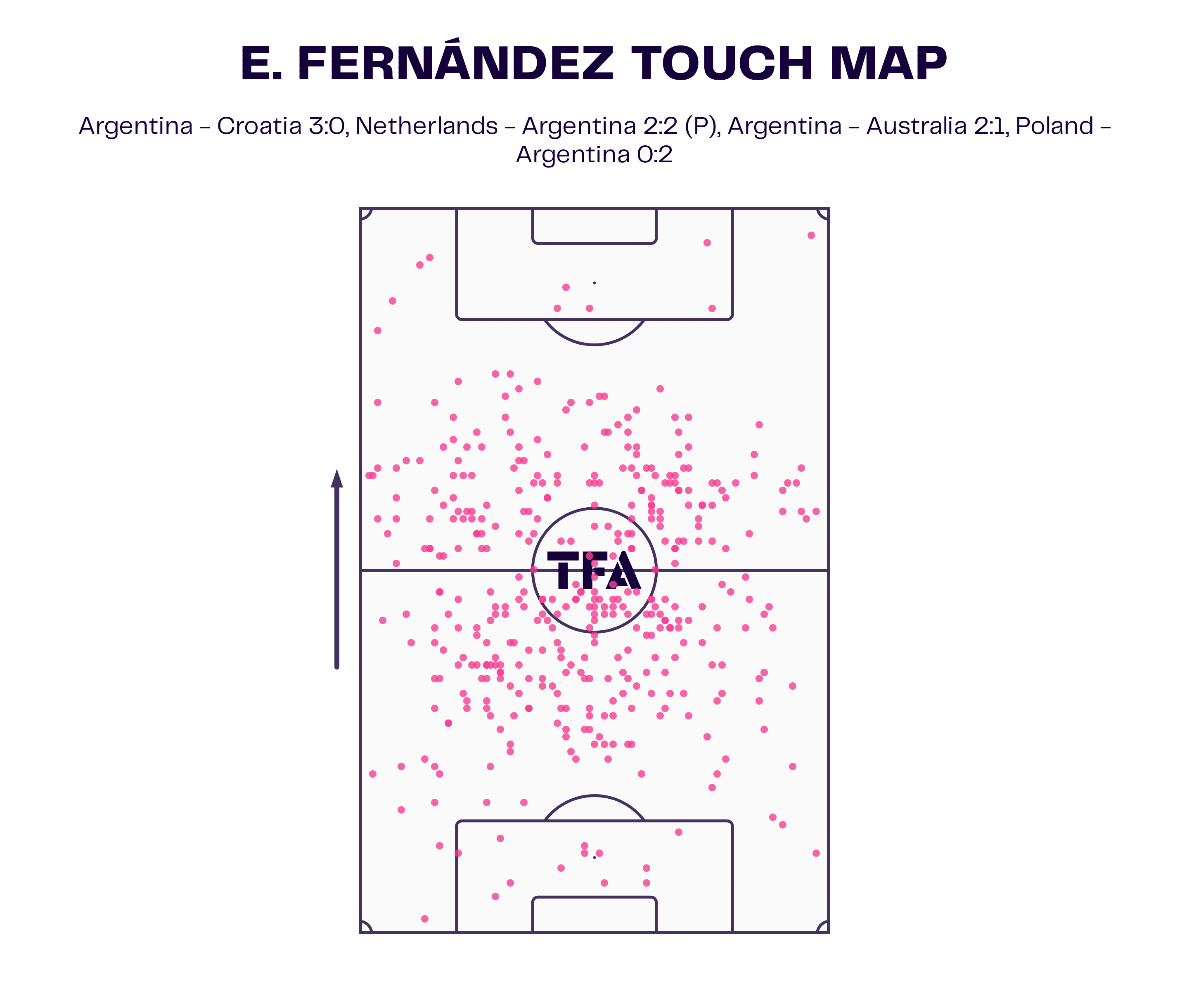
Fernández has generally featured as Argentina’s deepest-lying midfielder during this tournament. A lot of his passes occur just inside his own half of the pitch, as figure 1 displays.
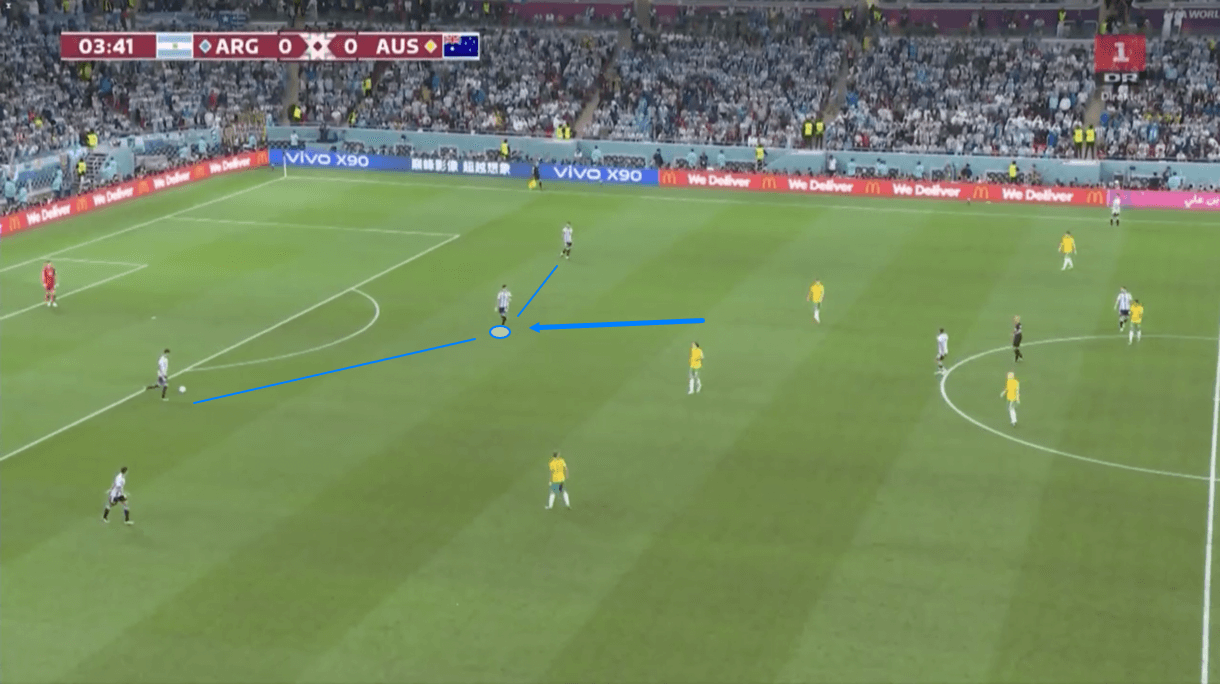
It’s common to see Fernández dropping between his team’s centre-backs as they split wide during the build-up allowing the full-backs to push on and thus, requiring a midfielder (often Rodrigo De Paul) to drop into the line just in front of the centre-backs to complete a 3-1 build-up shape.
Fernández doesn’t usually receive behind the opposition’s first line of pressure in this Argentina side, rather preferring to drop deeper than that and initiate ball progression from deep.
The Benfica man is generally quite a safe passer; his team trusts his common sense approach on the ball and trusts that he won’t take unnecessary risks in delicate areas, such as the position we see him occupying in figure 2.
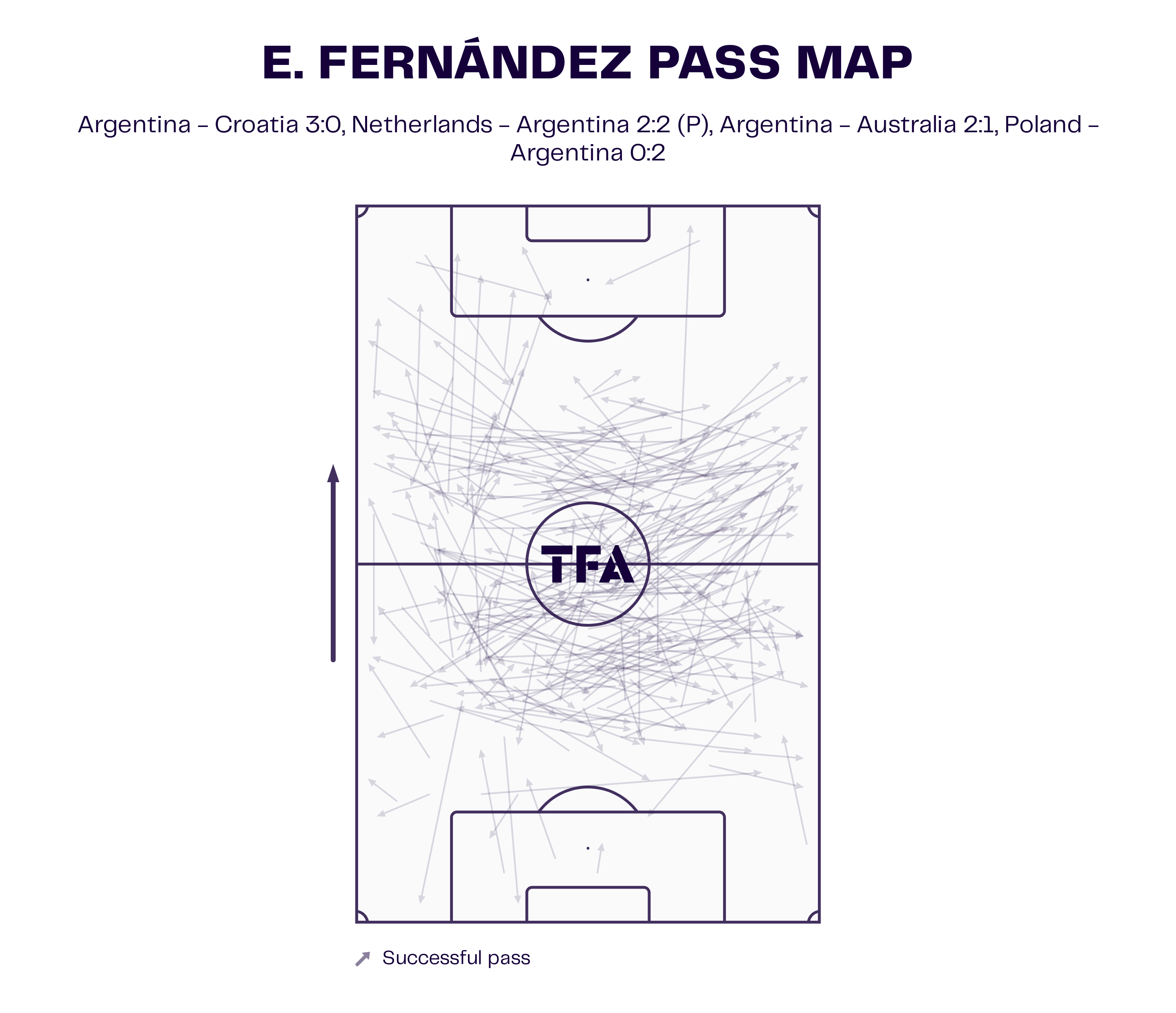
He plays plenty of passes sideways because of this, only trying to penetrate through the centre directly when the opportunity to play through this important area is very clearly on. Figure 3, Fernández’s pass map from the last four World Cup games — when this trio has started together — demonstrates his tendency to spread the ball out to wide areas, especially the right where he frequently finds Rodrigo De Paul. But more on that, later.
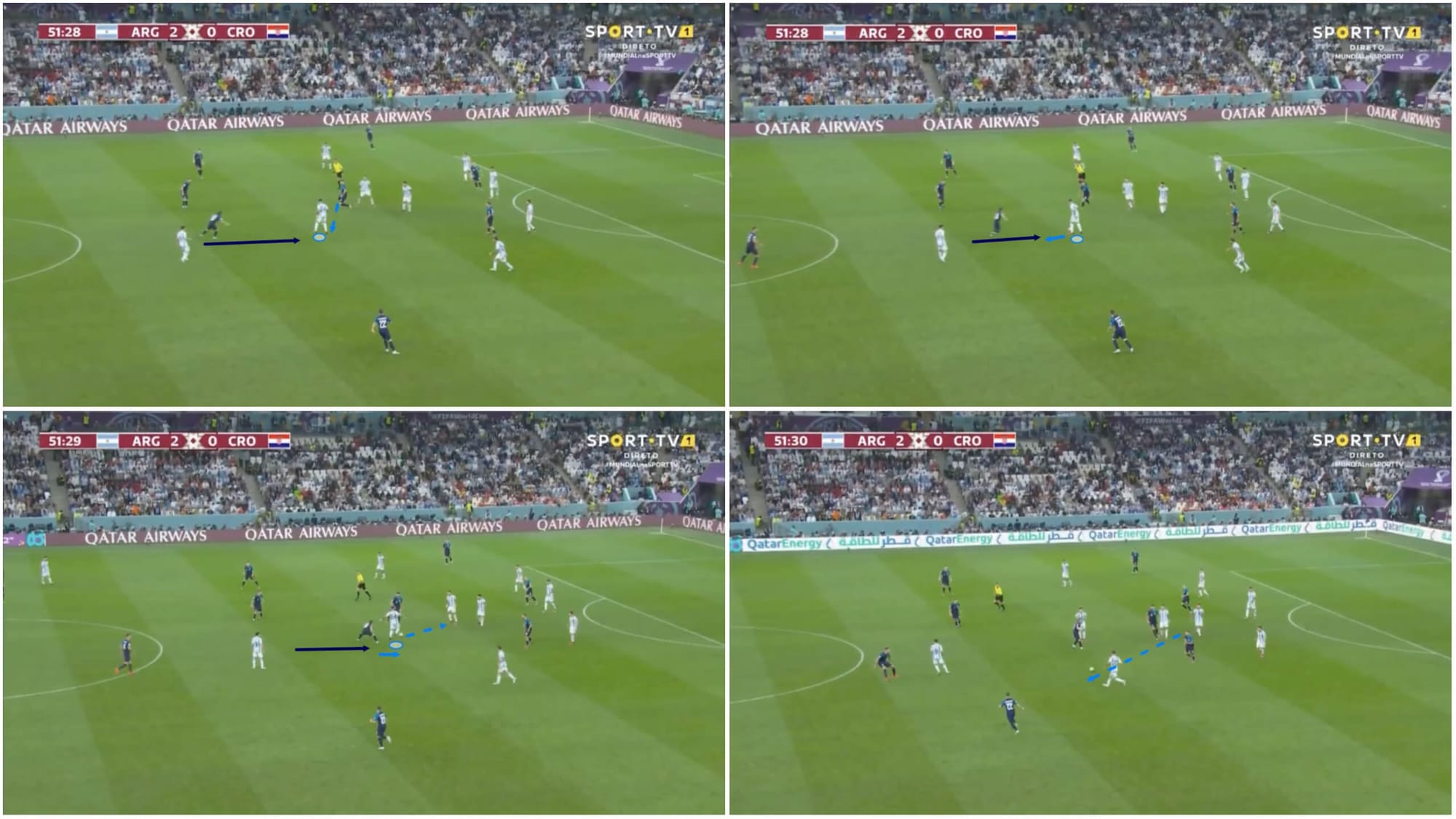
Fernández has demonstrated exemplary levels of press–resistance during the World Cup. He’s made it difficult for the opposition to really pressure him due to his composure on the ball and technical quality to escape pressure and get the ball out of sensitive areas, playing it away and helping his team play into a more spacious area.
We see an instance of this in figure 4. Fernández initially receives and turns out to play the ball forward. However, on recognising the incoming pressure, he turns back around and plays a simple pass to a free teammate just behind him, who can then spread the ball to a teammate in space just ahead of him and can push Argentina into the opposition’s half.
Here, Fernández demonstrates an excellent understanding of the need to take one step backwards in order to move forwards. His calmness and composure under pressure here to deal with this situation in a very sensible and effective manner show why Scaloni trusts him to play the role he plays in this team.
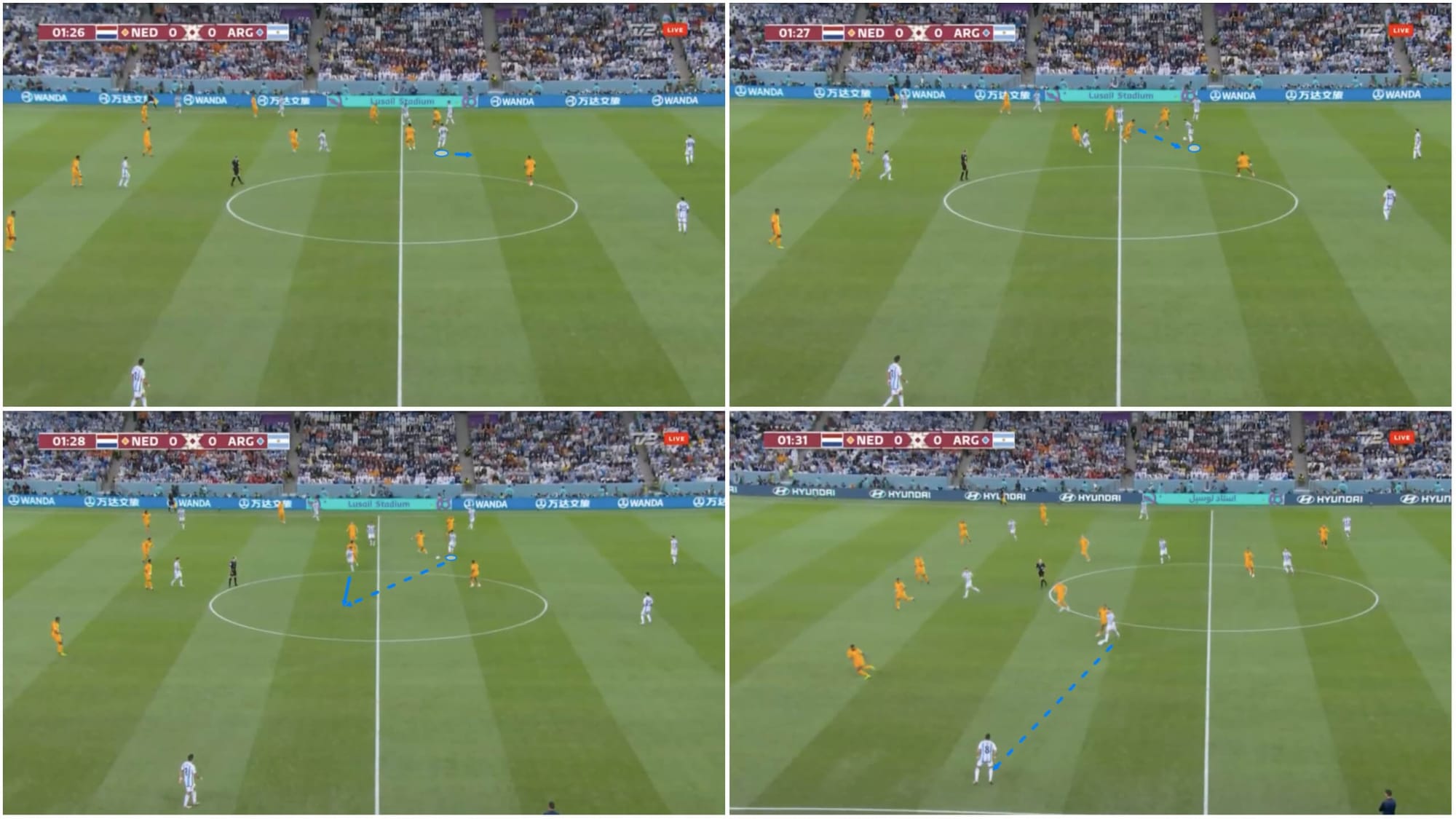
We see a similar example of Fernández helping his team to escape a highly congested area of the pitch and progress into a more promising area in figure 5.
Here, Fernández firstly does very well to back off into space and give the player on the ball a good passing option to escape the pressure. After receiving the ball, the Benfica man sends it through for a teammate ahead of him to chase. Note how the 21-year-old plays the ball into the space for the midfielder ahead of him to run into; this is very basic but another example of Fernández’s solid ability to perform basic, simple tasks very well under lots of pressure.
This pass kills the Netherlands’ pressure and allows Argentina to go on and escape to the opposite wing, where they have a lot more space to work with.
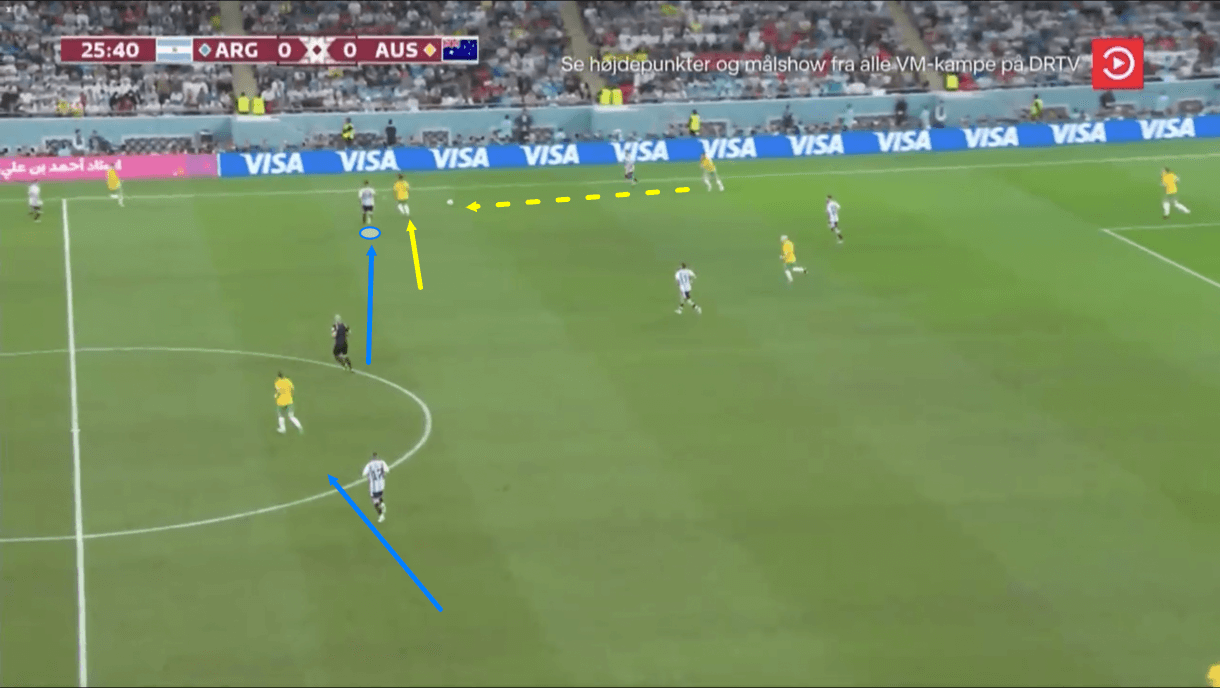
Defensively, Fernández is required to patrol the area in front of the centre-backs, this is a role that requires great positional awareness, particularly when defending in a compact block, but asks more of Fernández when his important role in defending against transitions is called into play.
Figure 6 shows an example of how Fernández can be dragged out of position in the transition to defence, requiring his winger on the opposite side to shift over and cover him. It’s important in Argentina’s set up for at least one winger / the wide midfielders to offer a lot in defensive phases, particularly in defensive transitions where they need to track back aggressively and help out their deeper teammates, including Fernández.
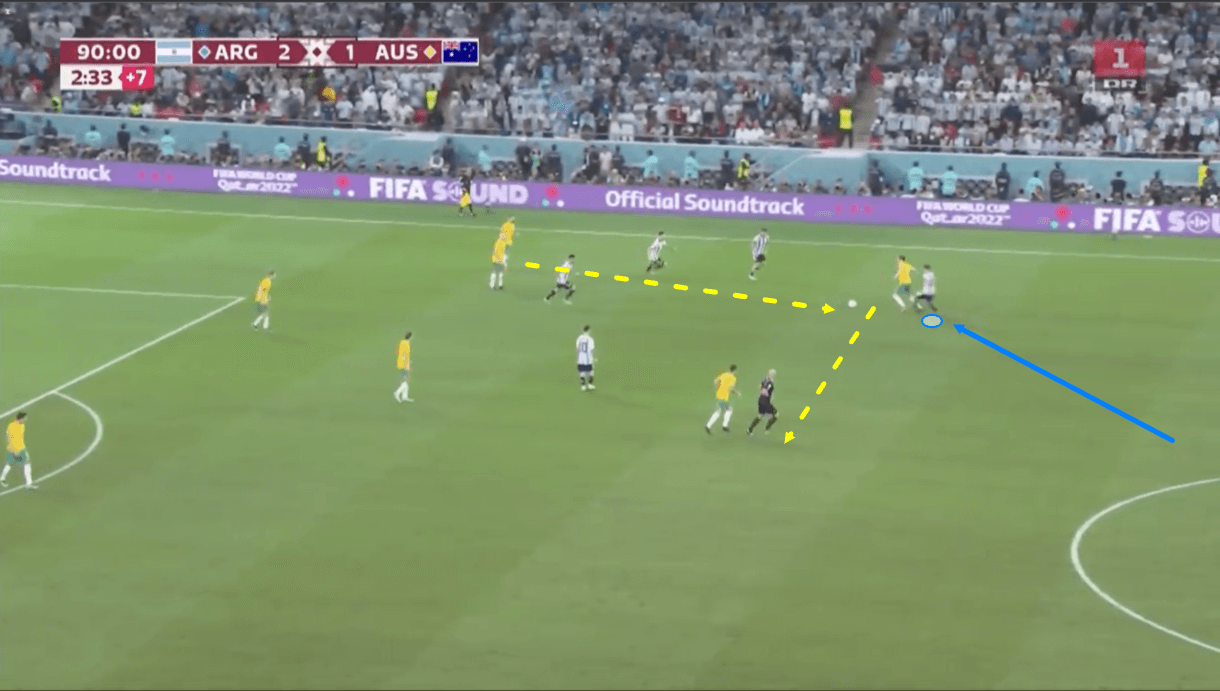
However, sometimes the 21-year-old can be caught out in transitions as he jumps to close down one player but leaves a window open for the opposition to get around him and exploit the space he’s just vacated, as occurred in the passage of play shown in figure 7. Timing and judgement are very important for Fernández when operating in such a vital role in the team’s defence, as being caught out of position like this can leave his team’s backline exposed and vulnerable.
Rodrigo De Paul
Rodrigo De Paul plays a significantly different role from Fernández in this squad. While Fernández is required to play it safe a lot of the time and participates a lot in the build-up, or initial phases of possession looking to break past the opposition’s first line, we’ll often see De Paul involved in slightly more advanced positions, receiving behind that first line of pressure or even further upfield, playing riskier balls but in a more creative role.
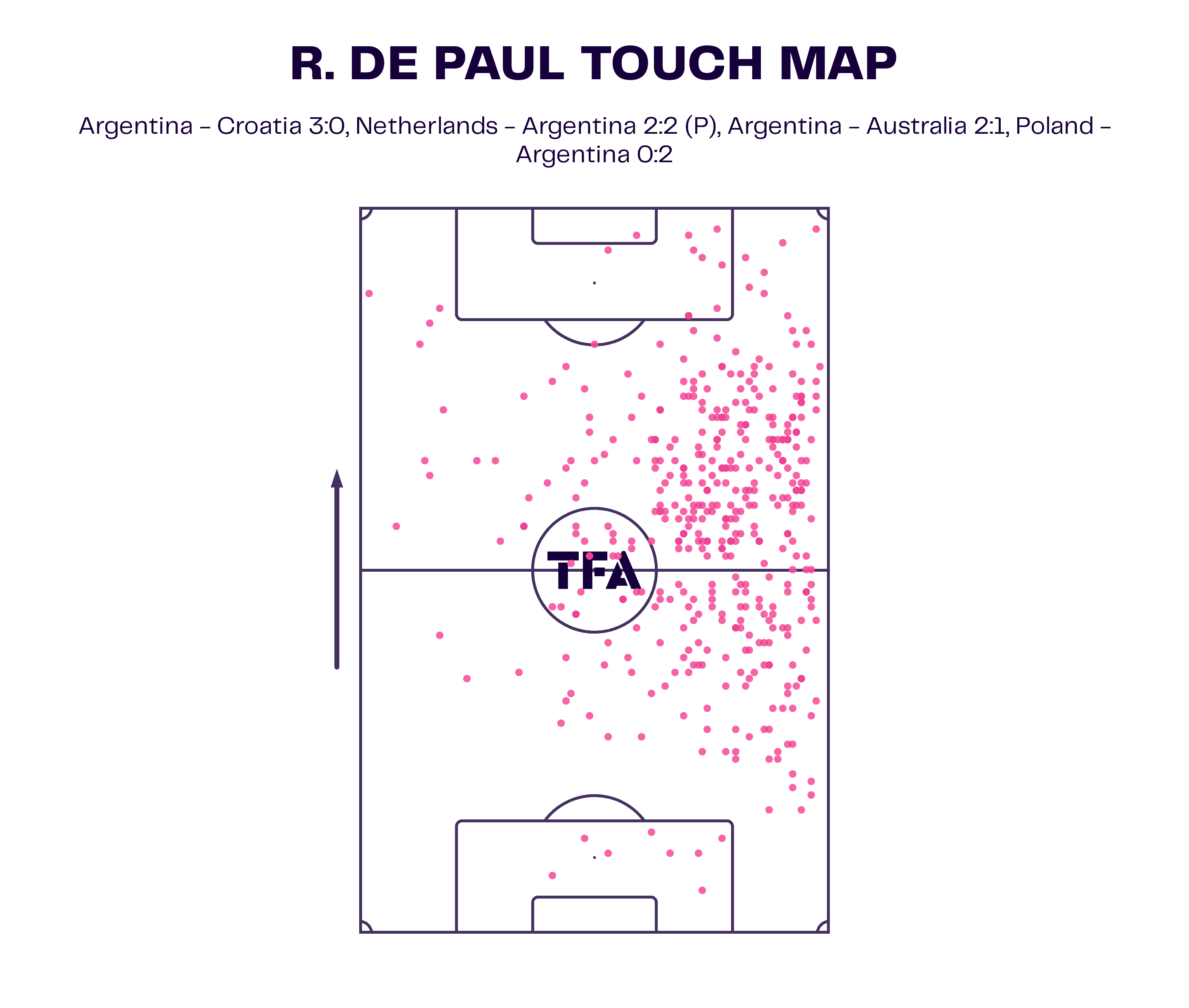
De Paul’s touch map in figure 8 highlights his more advanced, adventurous role in the squad, often spending time quite wide on the right. However, he can also be found dropping deep into the right half-space or even more centrally and everywhere in between. His is a role that potentially covers a lot of area.
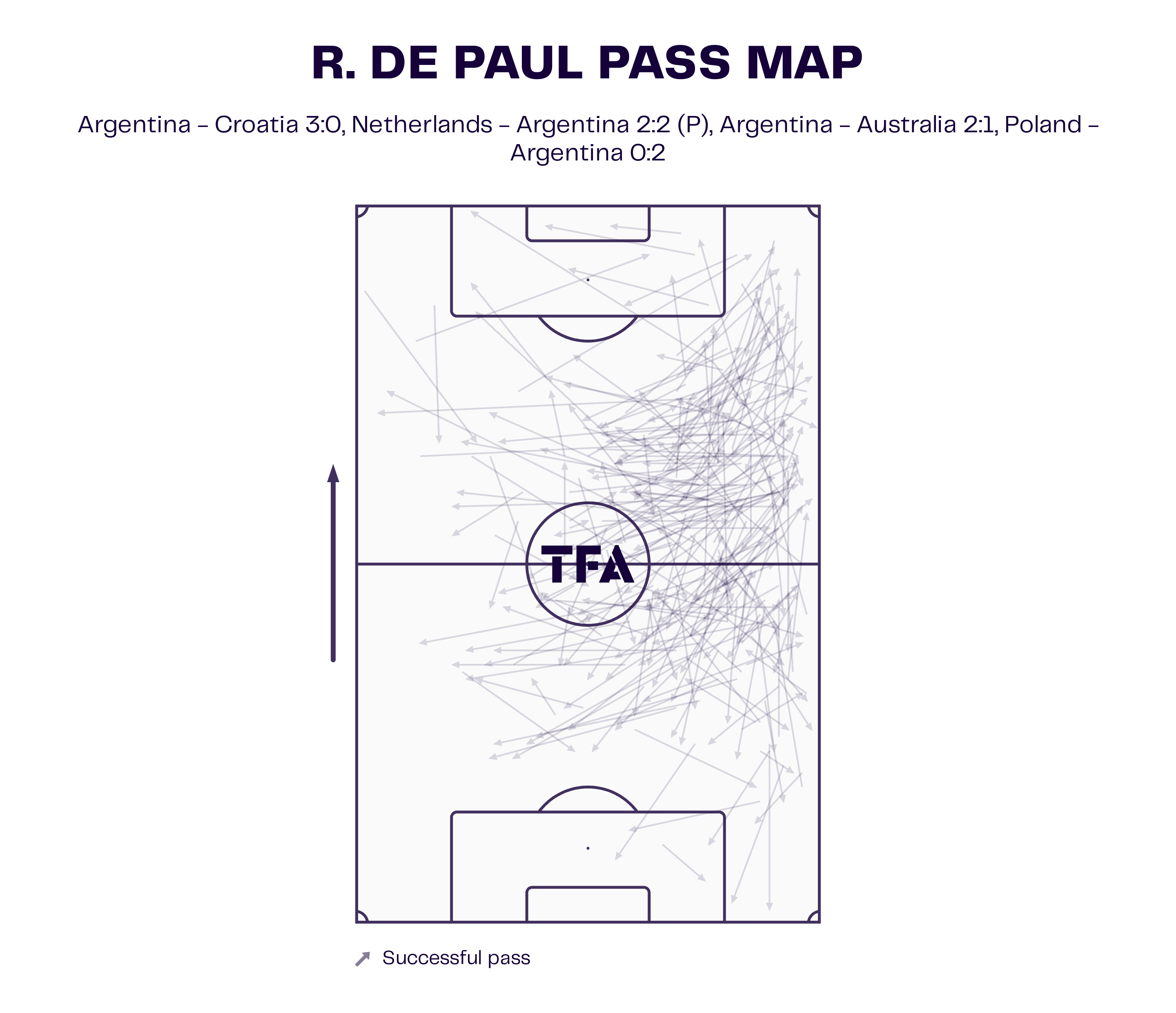
De Paul plays more forward passes than Argentina’s other midfielders. While Fernández and Mac Allister have pass accuracy rates of 91.03% and 91.04%, respectively, in the World Cup, De Paul’s pass accuracy rate is lower at 85.34%. De Paul isn’t there to be as safe as the others, he’s there to add a bit of dynamism and creativity to La Albiceleste’s midfield.
As the pass map in figure 9 also suggests, he plays plenty of passes into the right half-space and areas where you’d typically expect to find Argentina’s creative attackers, namely Messi, operating. So, De Paul’s ability to find and link up with these players is crucial to his team’s success.
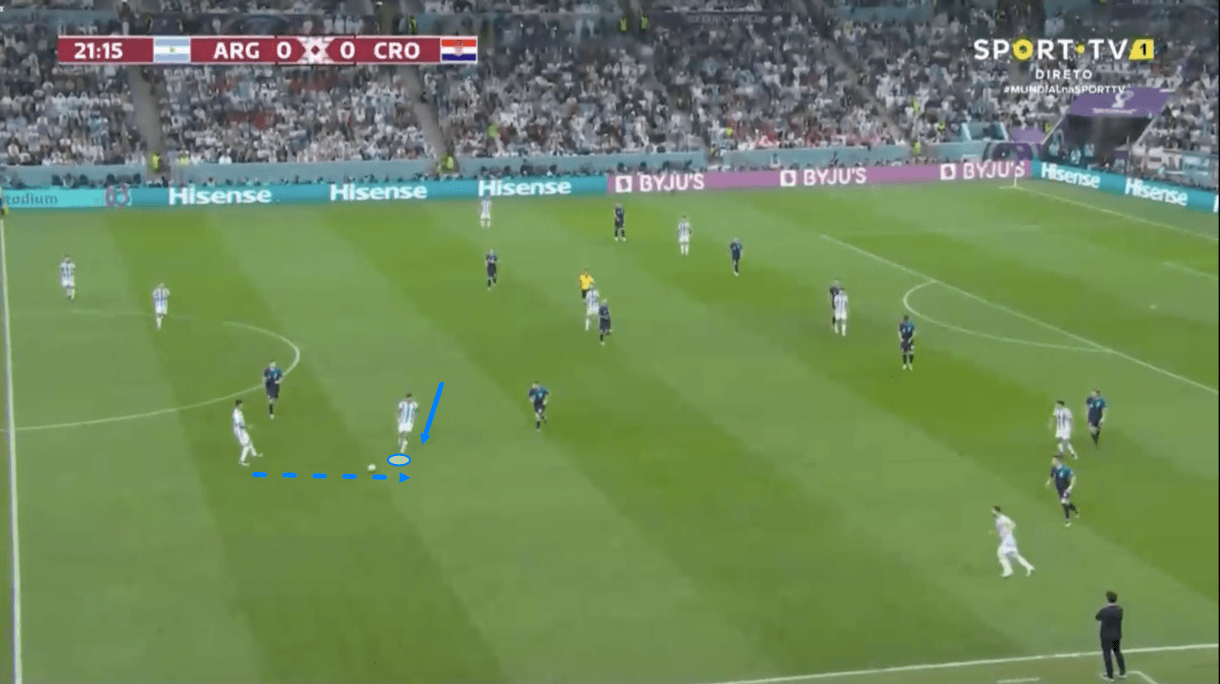
De Paul doesn’t need to just ‘find’ these players, like Messi, but he needs to find them and set them up for success. This is what separates him from others, yes, he will misplace passes at times — he’s playing a riskier role — but he’s trusted to be a reliable risk-taker who can play this role to the highest standard of what’s available.
Figures 10-11 show an example of De Paul drilling the ball unto a dropping forward’s feet in that right half-space area just inside the final third after he receives on the edge of the final third, more towards the centre of the pitch.
In figure 10, De Paul receives a slow, bobbling ball that seems to be a trivial part of a non-threatening period of Argentinian possession. However, at the same time, we see the Atlético Madrid man scanning with time and space to turn his body a bit and create an angle to move his team forward.
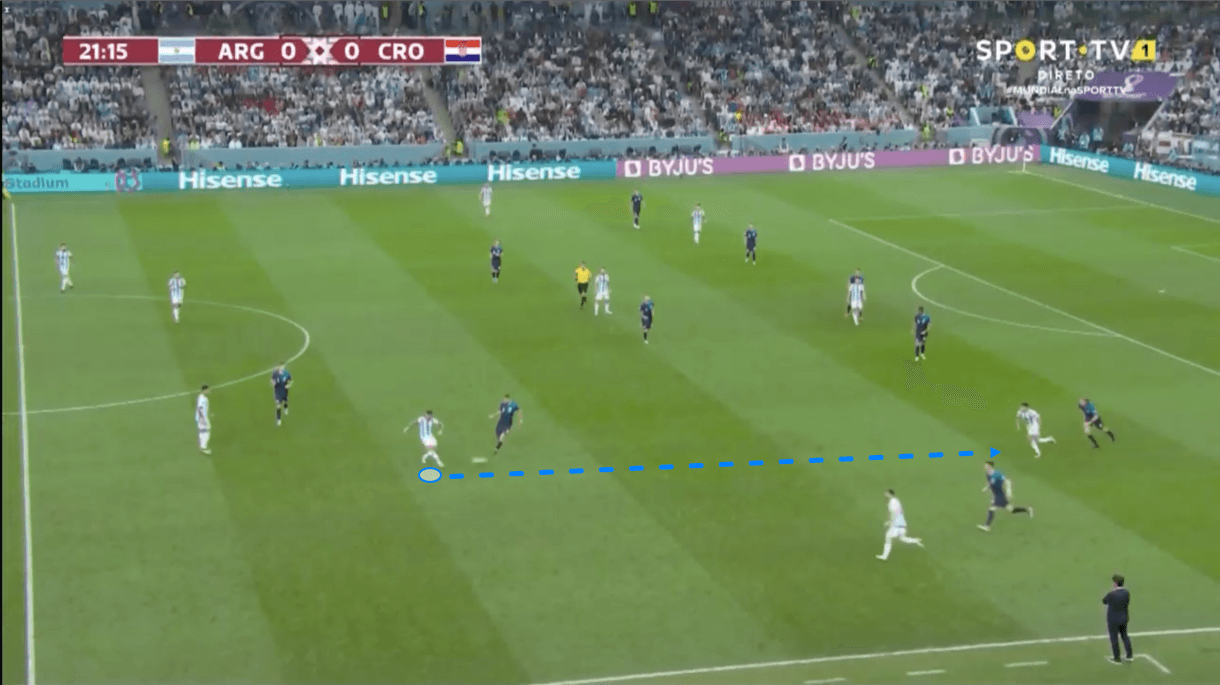
That time and space was all De Paul needed and like a flick of a switch, he instantly ups the tempo for Argentina by drilling the ball into the final third and creating a more threatening feel about the Argentinian attack.
Line-breaking balls and switches of tempo, playing killer passes out of nowhere — these are all key aspects of De Paul’s role within Scaloni’s side and explain his prominence for La Albiceleste in the World Cup Final run.
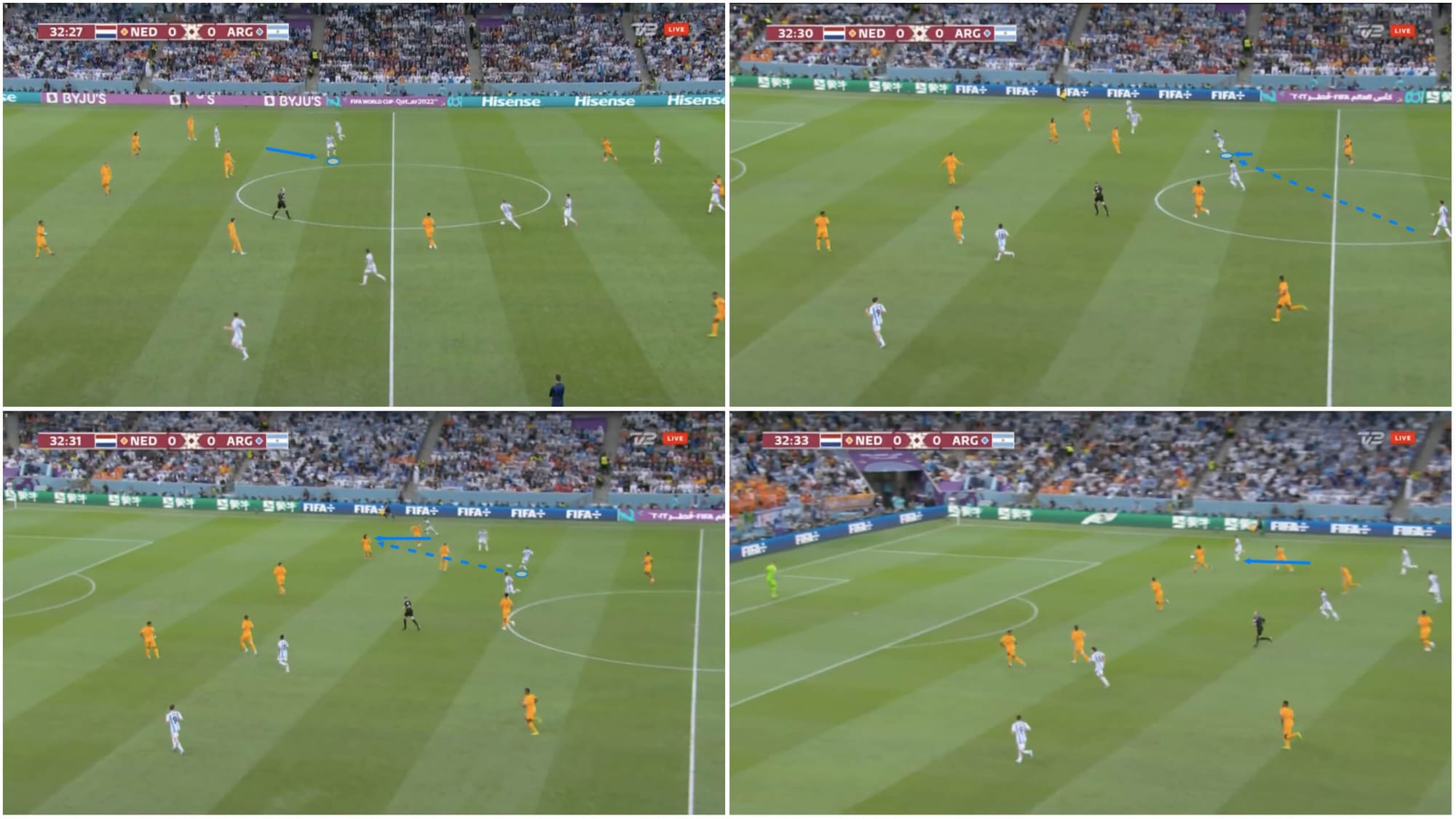
De Paul is an excellent creative passer. Wyscout defines a ‘smart pass’ as: “a creative and penetrative pass that attempts to break the opposition’s defensive lines to gain a significant advantage in attack”; according to Wyscout, De Paul has played more of those than any other central midfielder to have played at least 270 minutes (three full 90-minute games) in the competition.
We see an example of De Paul’s penetrative passing ability in figure 12, where he finds space, receives on the half-turn and splits the opposition’s defence open with a nice through ball that glides gently into the overlapping right-back’s path as the 28-year-old midfielder sets his team up to attack the opposition’s backline inside the final third.
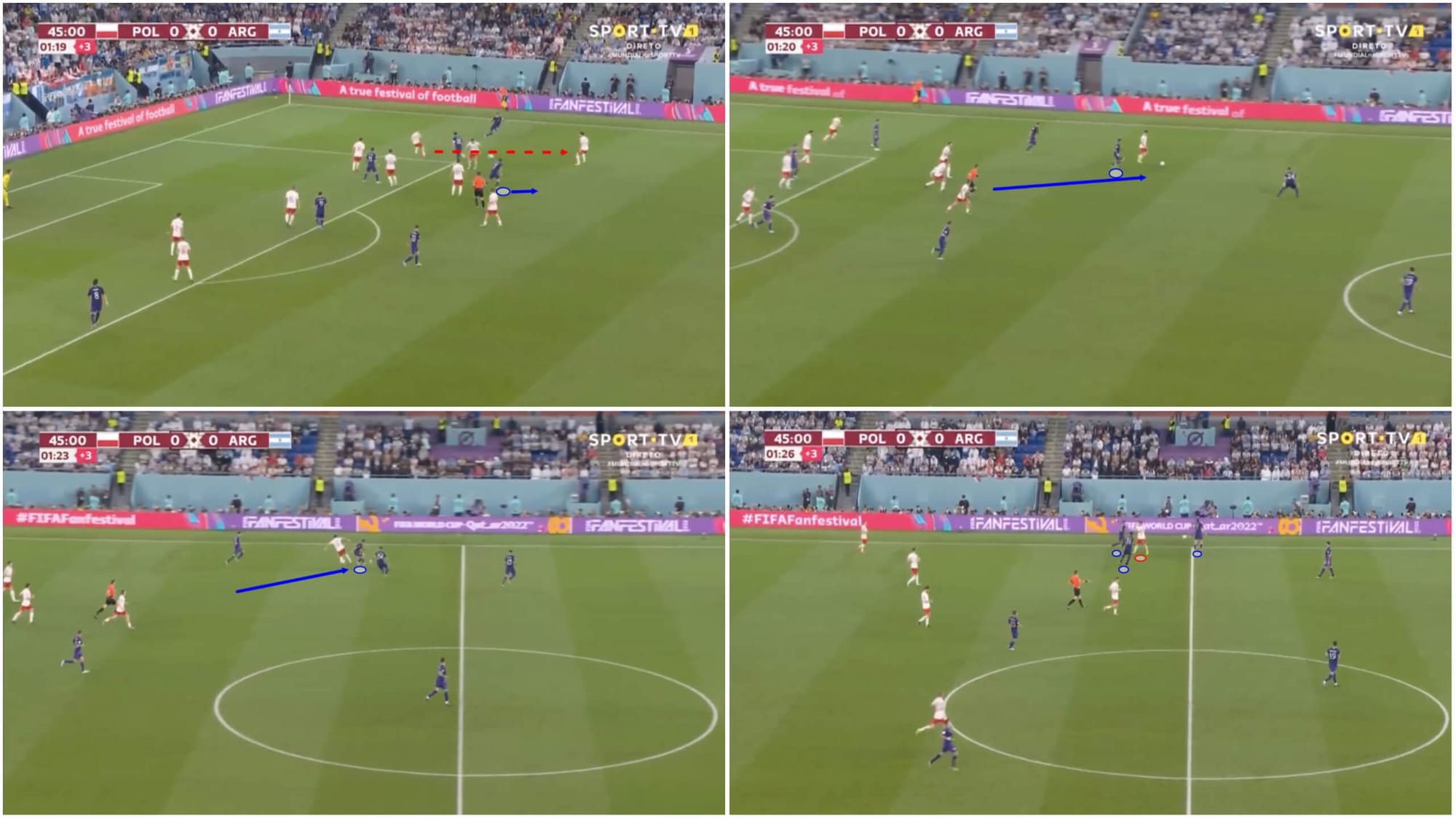
De Paul is more aggressive in defence than Fernández and presses with solid intensity throughout a given contest. Again, the wide midfielders are generally required to track back a lot with intensity in this Argentina side to offer support to their deep-lying teammates, especially in transition. De Paul is capable of offering great defensive work rate, with figure 13 providing an example of the Argentinian midfielder busting a gut to get back, stall the opposition ball carrier in transition and give his team a chance to regroup.
This defensive work rate and excellent defensive ability is a key component of De Paul’s role in this Argentina squad, along with his dynamic creative role in possession.
Alexis Mac Allister
Alexis Mac Allister of EPL side Brighton and Hove Albion makes up the third part of this midfield trio that has featured the most for Argentina throughout the 2022 World Cup. His role resembles Fernández’s more than De Paul’s with regard to risk-taking requirements in possession but resembles De Paul’s more than Fernández’s when you look at the positions the 23-year-old typically occupies.
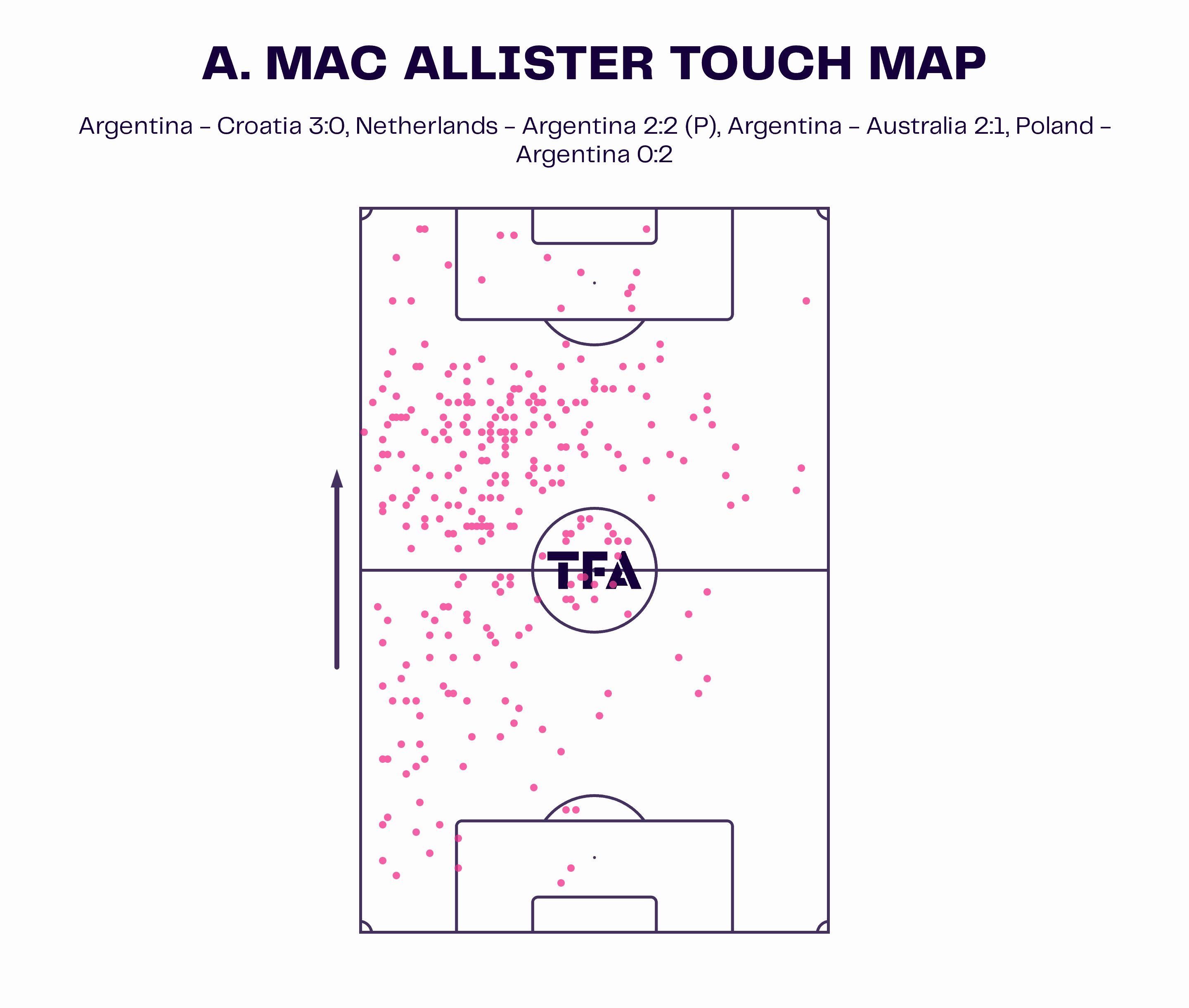
Mac Allister usually plays as the left midfielder to De Paul’s right midfielder, but tends to occupy more central spaces a lot of the time. If Fernández is the holding midfielder and De Paul is the ‘8’ who you may find anywhere on the right side of the pitch, Mac Allister could aptly be described as the most advanced midfielder for Argentina most of the time, despite De Paul typically being the one who shoulders the most direct creative responsibility.
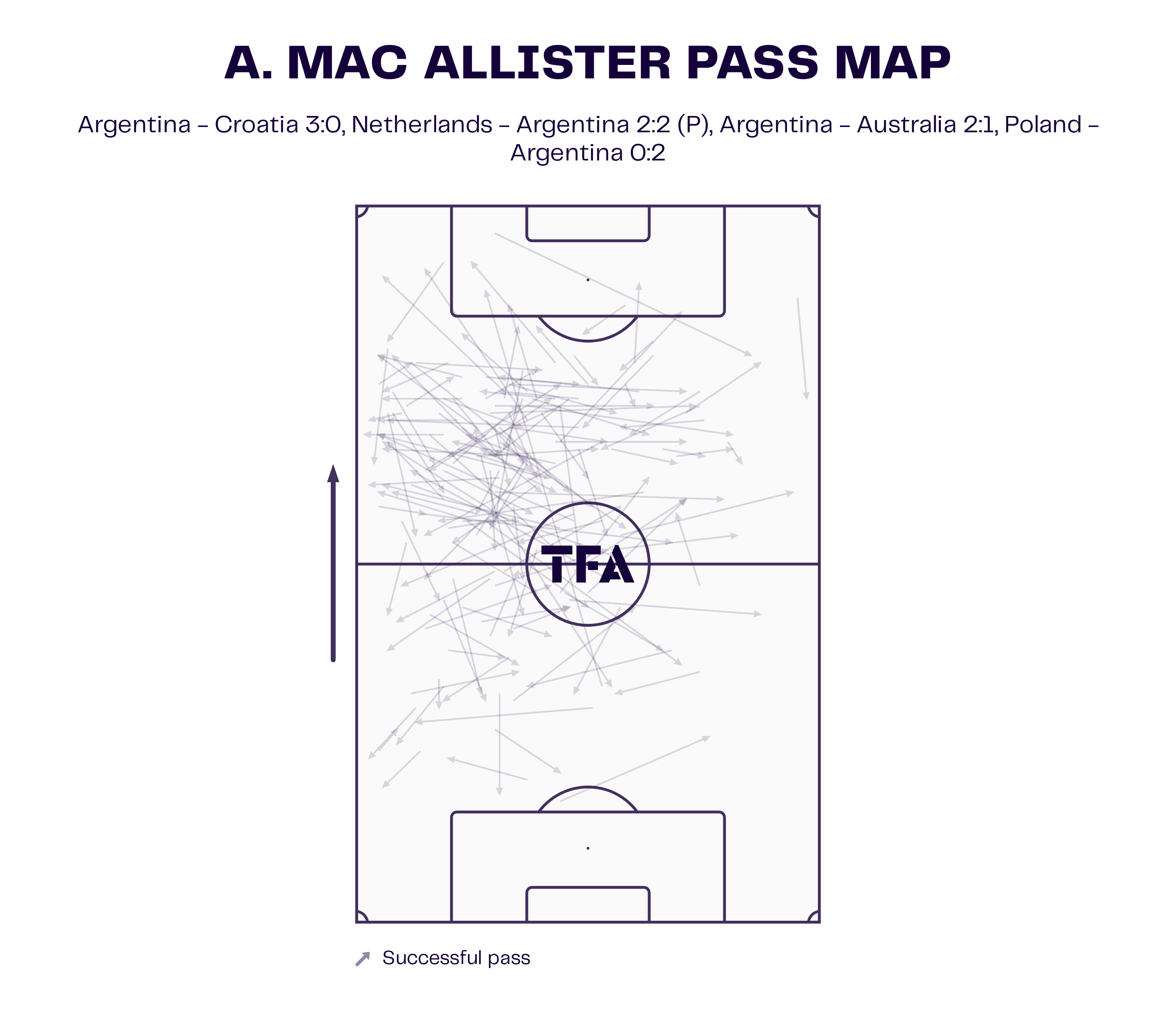
There’s a lot of backward and sideways passing in Mac Allister’s game, as figure 15 shows. Additionally, he tends not to get very involved in or around the edge of the box, generally staying between the halfway line and the ‘D’ on the edge of the box; this is Mac Allister’s territory.
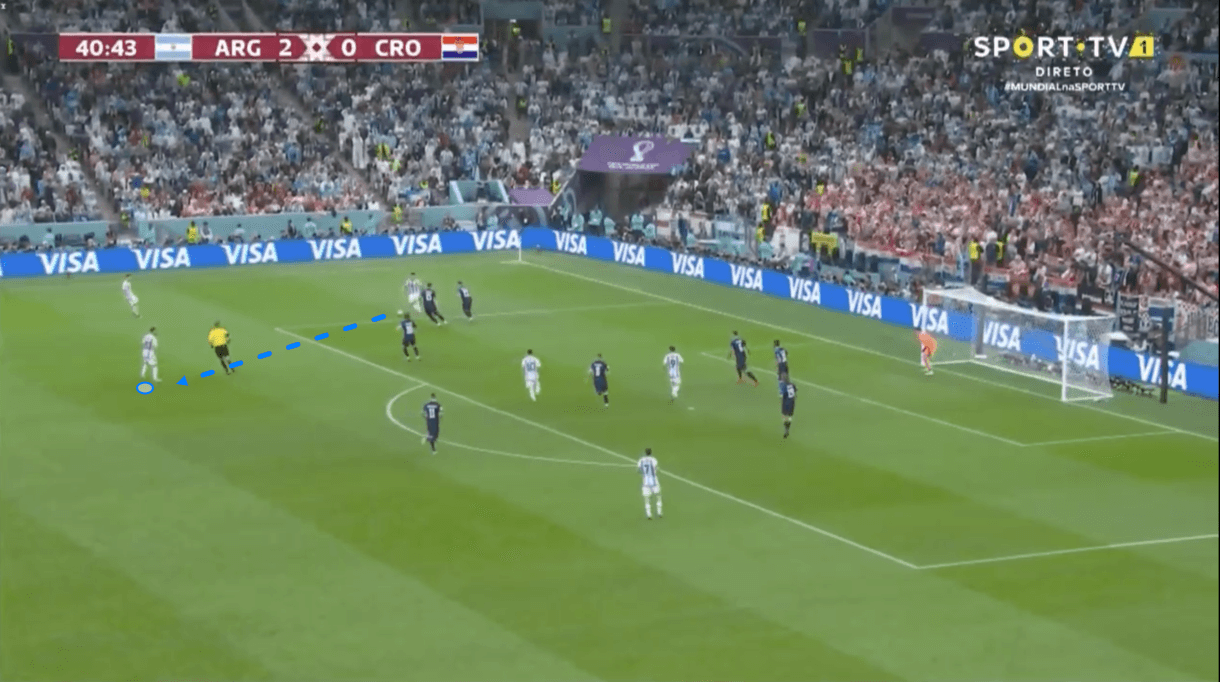
So, what is Mac Allister’s game in relation to Scaloni’s squad and these midfield dynamics? One key element of Mac Allister’s game is finding space just outside the box when his team is inside the final third and making himself available to link players up with each other when the direct pass between the two players is impossible to achieve, such as figures 16-17.
In figure 16, the Brighton man has found lots of space on the outer rim of the final third with his team having advanced to the edge of the box. We see a perfect example of the ‘Mac Allister territory’ previously discussed in action in this image.
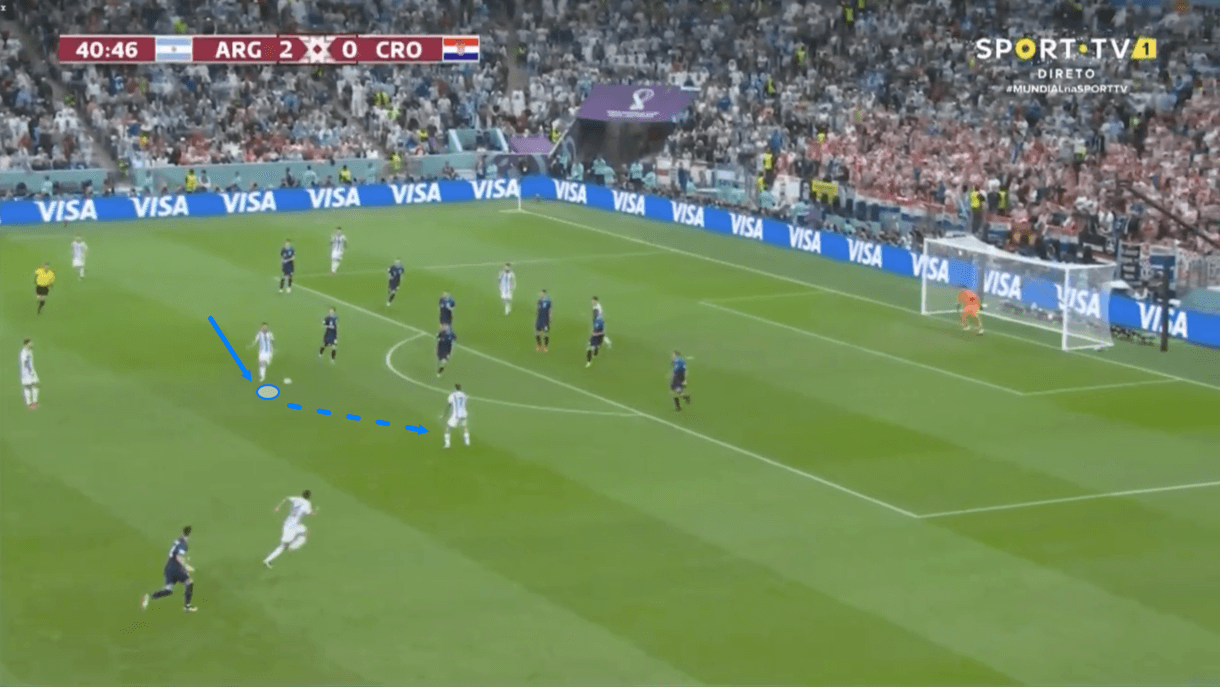
After receiving, the midfielder turns and delivers the ball to creator De Paul in the right half-space, shifting the ball across from one side to the other and putting his team in a much more dangerous position in a matter of seconds.
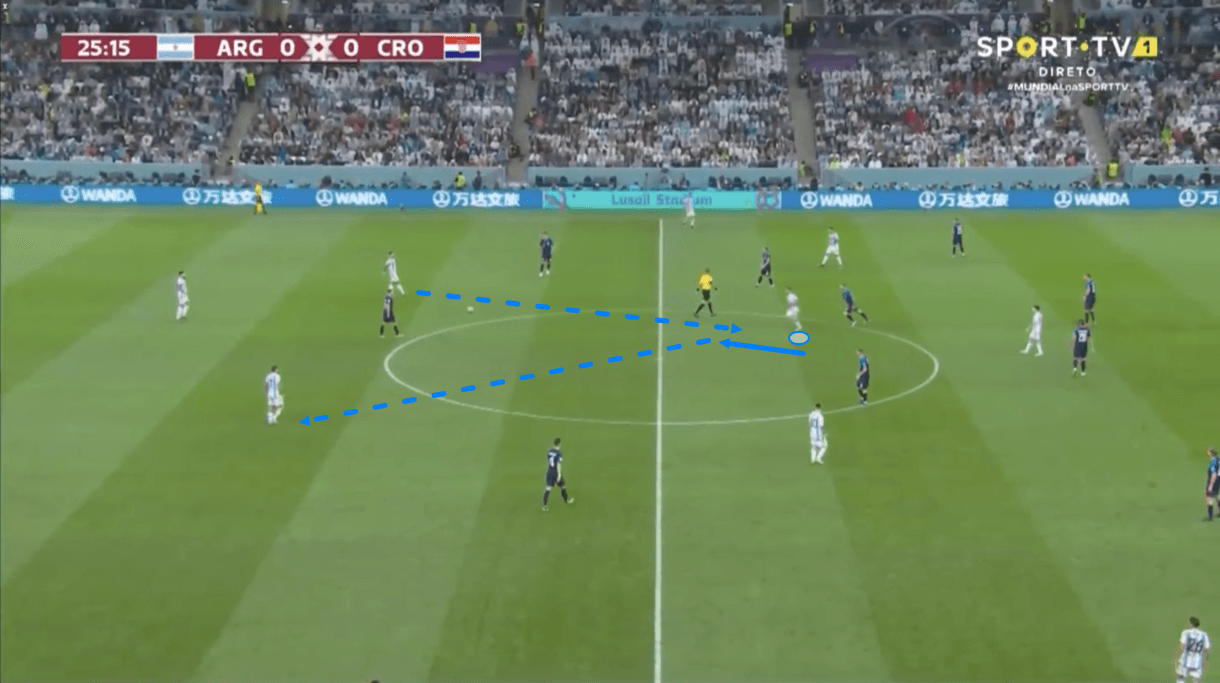
The connector links play between two deeper Argentinian players in figure 18. Here, the left midfielder drops from a central position, catching the opposition defender next to him off-guard and creating a triangle that helps him to link up play between two deep players who had been cut off from one another and aid La Albiceleste’s progression.
So, acting as this linkman is a crucial element of Mac Allister’s game in possession. He won’t directly kill you or set up the murder but he will assist in vital ways in transporting the assassins to the necessary location; a key connector in Argentina’s possession game.
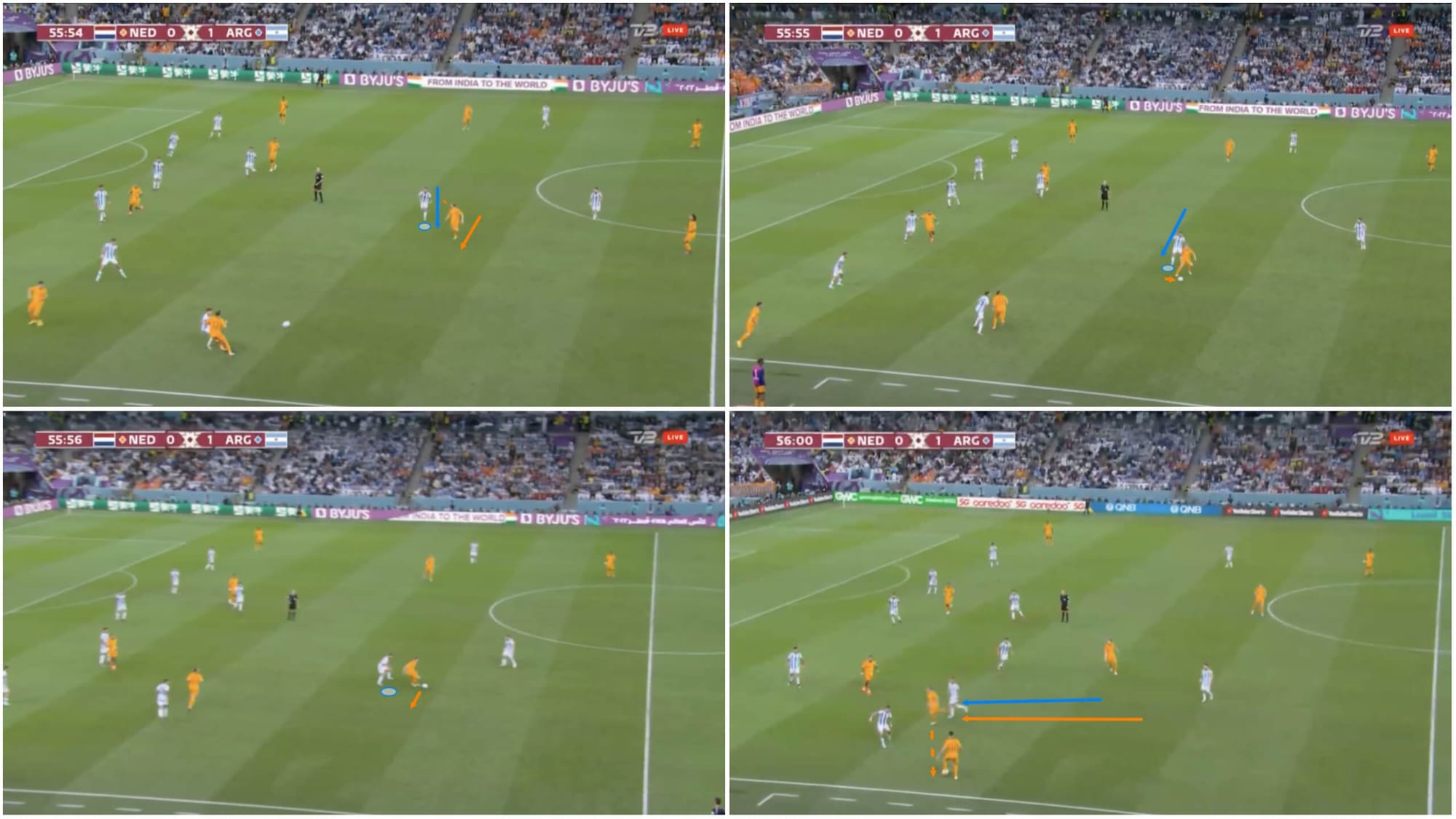
Mac Allister’s marking has been exquisite at times during this tournament; he seems happy to be a guard dog at times and harry talented opposition players. He did an excellent marking job on Luka Modrić to help Argentina nullify one of Croatia’s biggest threats and reach the final, while we see him pacifying the Netherlands’ Frenkie de Jong in figure 19, preventing him from playing his team forward through Argentina’s shape and forcing him to play a backwards pass out to the left-back.
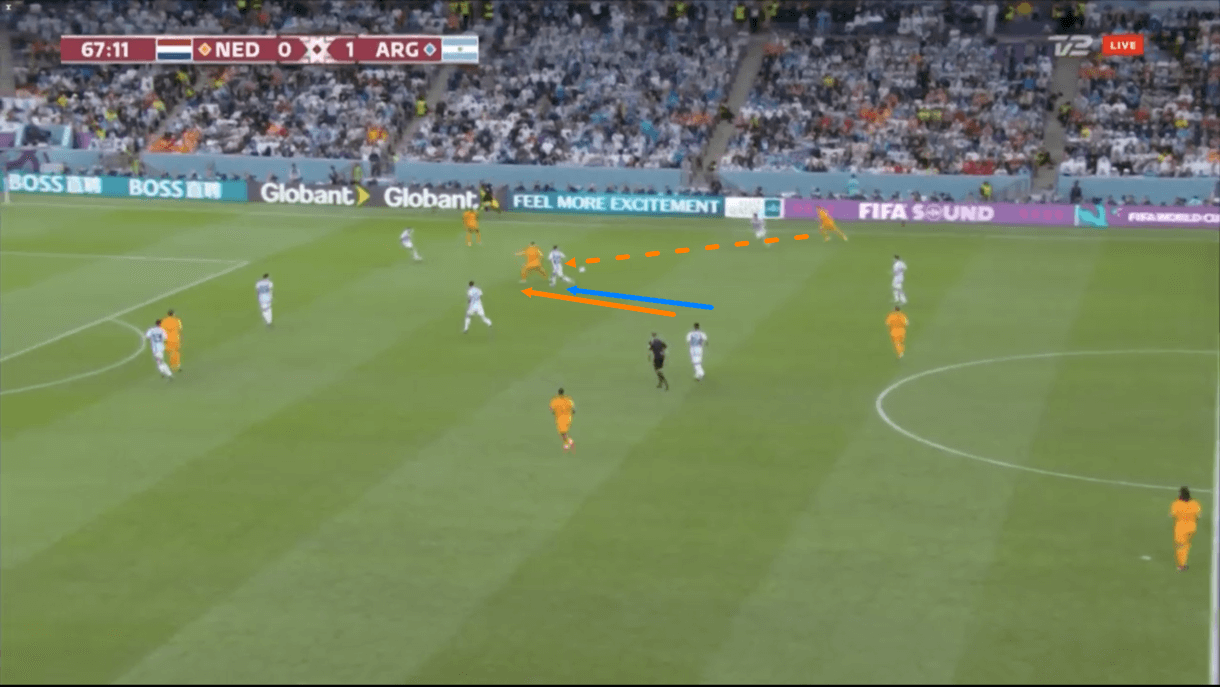
Similar to De Paul on the other side, Mac Allister is also required to do a lot of intense tracking back and performs this role diligently for Scaloni’s men, again highlighting why he’s been such a key component of this side, along with his role in possession which forms a vital piece of the jigsaw for Scaloni in putting together his attacking agenda.
Conclusion
To conclude this tactical analysis and scout report, we hope that the specific roles of the three midfielders we’ve discussed in this piece within Scaloni’s tactics are clear from our analysis. All three men perform distinctly different roles that come together to form what’s been a formidable midfield for Argentina since they’ve settled into the squad alongside each other.
Can France find a way to extinguish the flames of Argentina’s midfield on Sunday or will La Albiceleste win one more game and bring the World Cup back to Argentina for the first time since 1986? Only time will tell, but Argentina have been on fire of late and it’ll take a top plan and performance from Didier Deschamps and his men to overcome the final hurdle standing in the way of them retaining their World Cup crown.





Comments